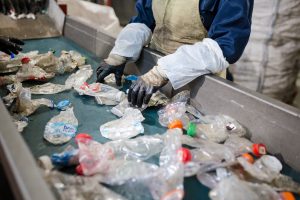
Canada Plastic Pact releases new ‘Roadmap to 2025’ action plan
Canadian Plastics
Canadian Plastics Packaging Plastics Processes Recycling Sustainability editor pickThe plan focuses on three strategic priorities to improve plastics recycling and move Canada towards a circular economy by 2025.

Photo Credit: Adobe Stock/Pavel
Over 70 leading businesses, organizations, and governments have come together to release a new plan to eliminate plastic waste in Canada through the Canada Plastics Pact (CPP).
Called Roadmap to 2025, the plan is being described as “the most significant action plan to reduce plastic waste in Canadian history”, with the goal of achieving “tangible change” towards a circular economy in Canada by 2025, CPP said in an Oct. 21 news release.
“Our take-make-waste approach to plastics is no longer viable,” said George Roter, CPP’s managing director. “Plastic packaging is a vital part of daily life, it is high-performing, lightweight, and low cost; but currently, over 85 per cent of what we produce in Canada each year gets used once and ends up in landfills or the environment. The Roadmap is designed to comprehensively address this problem quickly and together”.
The Roadmap advocates three strategic priorities for 2025:
1 REDUCE, REUSE, COLLECT
The goal is to eliminate unnecessary and hard to recycle plastics. “Over two-thirds of the plastics packaging that is produced in Canada goes to landfill or leaks into the environment, before ever being placed in a blue bin or entering the recycling system,” CPP said. “Addressing this challenge will require a multi-dimensional approach, in particular innovation upstream of the recycling system.” Unnecessary, hard-to- collect, hard-to-sort, and hard-to-recycle packaging – formats and resins that almost exclusively end up in landfill, are not collected, or which leak into the environment – must be phased out entirely, CPP said.
2 OPTIMIZE THE RECYCLING SYSTEM
“Recirculating plastics packaging presents significant challenges – both in the supply of plastics to the recycling system and on the demand side, regarding the incorporation of recycled content,” CPP said. “To overcome these, [we] will improve the quality of inputs to the recycling system by driving wide adoption of circular packaging design standards, which will improve recyclability, and drive changes that will reduce fossil-based plastic packaging use overall.” The CPP also says it will also gather and share evidenced-based research to ensure producers and others financing the recycling system have information to make investment decisions for new recycling infrastructure. “And, we will boost demand for recycled resin through focused efforts to address some of the technical challenges for incorporating recycled resins, particularly in food contact and flexible applications, and inform relevant policies,” CPP said.
3 USE DATA TO IMPROVE THE WHOLE SYSTEM
There are significant challenges facing the identification of the most crucial activities and strategies to accelerate the circular transition, including: the absence of a common language; poor communication between key actors in the plastics packaging ecosystem (for example, between packaging designers and MRF operators); and lack of information about what plastic packaging is generated, where it goes, and how it is used and collected, particularly for the industrial, commercial and institutional (IC&I) sector. The CPP will improve the performance of recycling systems by championing standard definitions and measurement practices. The CPP will also champion development of a nationally comprehensive view of what packaging is put on the market, where it goes, and what is collected, sorted, recycled, and reprocessed, with a specific focus on areas of weakness (e.g. the IC&I system). “And, we will work to drive investment into better real-time data and monitoring,” they said.
The Roadmap also identifies the need to improve “highly under-optimized” recycling structures, chief among them films and flexible packaging, which CPP says has recycling rates of only one per cent. “We will make this a special cross-cutting focus across all of the strategic priorities and many of the key outcomes,” CPP said.
The ultimate goal of the new Roadmap is to help achieve the CPP’s four 2025 targets for plastics packaging and waste, which CPP partners are required to report on annually. These are to define a list of plastic packaging that’s to be designated as problematic or unnecessary and take measures to eliminate them by 2025; support efforts towards 100 per cent of plastic packaging being designed to be reusable, recyclable or compostable by 2025; ensure that at least 50 per cent of plastic packaging is effectively recycled or composted by 2025; and ensure an average of at least 30 per cent recycled content across all plastic packaging (by weight) by 2025.
The CPP was launched in January 2021, originally with a group of more than 40 Canadian companies, with the goal of recycling or composting 50 per cent of Canada’s plastic packaging by 2025. About 30 other companies have joined since then. Members include Coca-Cola Canada, Loblaw Companies Ltd., Maple Leaf Foods, Keurig Dr. Pepper Canada, Merlin Plastics, Unilever Canada, Walmart Canada, the Government of British Columbia, Nestlé Canada, and Nova Chemicals Corp.
The CPP also advocates working closely with the U.S. Plastics Pact, which launched last year and released its own detailed road map in June 2021. Both the Canadian and U.S. pacts and others around the world are part of a network organized by the Ellen MacArthur Foundation.
